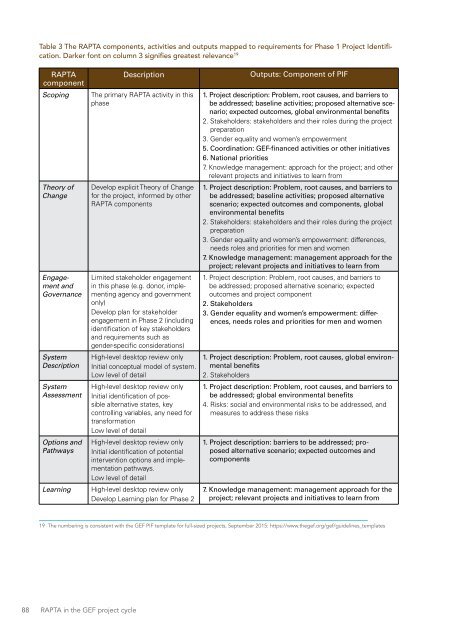DESIGNING PROJECTS IN A RAPIDLY CHANGING WORLD
srun3013fp1
srun3013fp1
You also want an ePaper? Increase the reach of your titles
YUMPU automatically turns print PDFs into web optimized ePapers that Google loves.
Table 3 The RAPTA components, activities and outputs mapped to requirements for Phase 1 Project Identification.<br />
Darker font on column 3 signifies greatest relevance 19<br />
RAPTA<br />
component<br />
Scoping<br />
Theory of<br />
Change<br />
Engagement<br />
and<br />
Governance<br />
System<br />
Description<br />
System<br />
Assessment<br />
Options and<br />
Pathways<br />
Learning<br />
Description<br />
The primary RAPTA activity in this<br />
phase<br />
Develop explicit Theory of Change<br />
for the project, informed by other<br />
RAPTA components<br />
Limited stakeholder engagement<br />
in this phase (e.g. donor, implementing<br />
agency and government<br />
only)<br />
Develop plan for stakeholder<br />
engagement in Phase 2 (including<br />
identification of key stakeholders<br />
and requirements such as<br />
gender-specific considerations)<br />
High-level desktop review only<br />
Initial conceptual model of system.<br />
Low level of detail<br />
High-level desktop review only<br />
Initial identification of possible<br />
alternative states, key<br />
controlling variables, any need for<br />
transformation<br />
Low level of detail<br />
High-level desktop review only<br />
Initial identification of potential<br />
intervention options and implementation<br />
pathways.<br />
Low level of detail<br />
High-level desktop review only<br />
Develop Learning plan for Phase 2<br />
Outputs: Component of PIF<br />
1. Project description: Problem, root causes, and barriers to<br />
be addressed; baseline activities; proposed alternative scenario;<br />
expected outcomes, global environmental benefits<br />
2. Stakeholders: stakeholders and their roles during the project<br />
preparation<br />
3. Gender equality and women’s empowerment<br />
5. Coordination: GEF-financed activities or other initiatives<br />
6. National priorities<br />
7. Knowledge management: approach for the project; and other<br />
relevant projects and initiatives to learn from<br />
1. Project description: Problem, root causes, and barriers to<br />
be addressed; baseline activities; proposed alternative<br />
scenario; expected outcomes and components, global<br />
environmental benefits<br />
2. Stakeholders: stakeholders and their roles during the project<br />
preparation<br />
3. Gender equality and women’s empowerment: differences,<br />
needs roles and priorities for men and women<br />
7. Knowledge management: management approach for the<br />
project; relevant projects and initiatives to learn from<br />
1. Project description: Problem, root causes, and barriers to<br />
be addressed; proposed alternative scenario; expected<br />
outcomes and project component<br />
2. Stakeholders<br />
3. Gender equality and women’s empowerment: differences,<br />
needs roles and priorities for men and women<br />
1. Project description: Problem, root causes, global environmental<br />
benefits<br />
2. Stakeholders<br />
1. Project description: Problem, root causes, and barriers to<br />
be addressed; global environmental benefits<br />
4. Risks: social and environmental risks to be addressed, and<br />
measures to address these risks<br />
1. Project description: barriers to be addressed; proposed<br />
alternative scenario; expected outcomes and<br />
components<br />
7. Knowledge management: management approach for the<br />
project; relevant projects and initiatives to learn from<br />
19 The numbering is consistent with the GEF PIF template for full-sized projects, September 2015: https://www.thegef.org/gef/guidelines_templates<br />
88 RAPTA in the GEF project cycle


